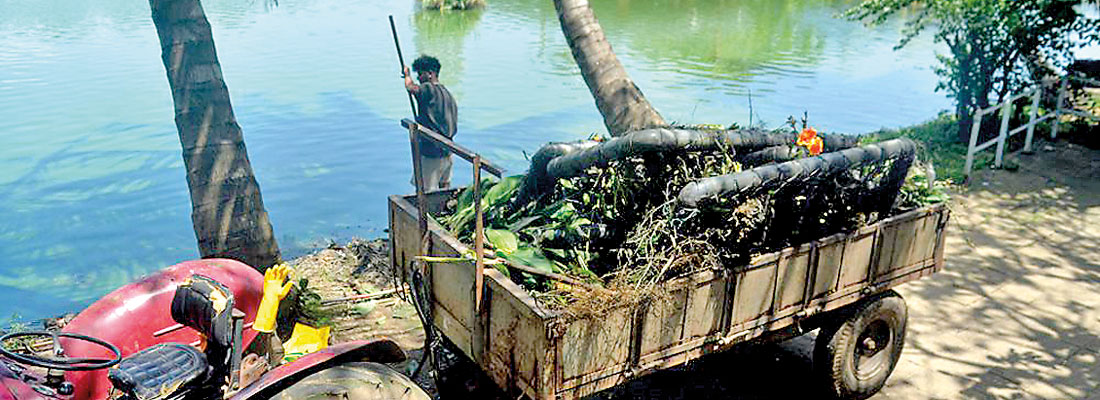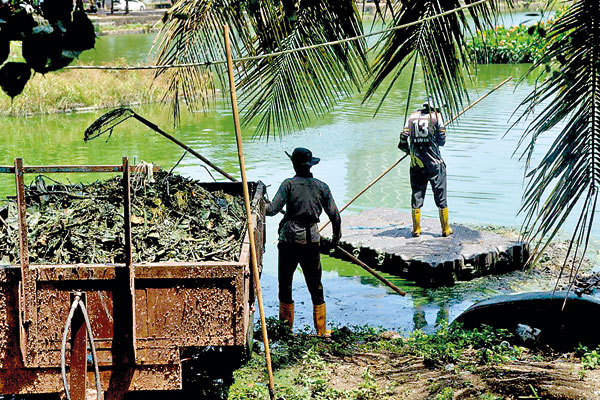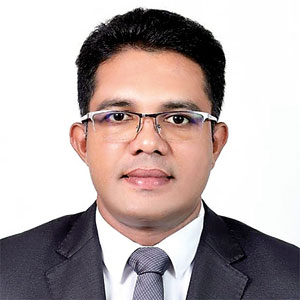News
A breath of new life to the Beira
View(s):By Dilushi Wijesinghe
“This time we are not just skimming the surface. The focus is to stop sewer inflows into the lake permanently,” said Chathura Kahandawarachchi, who chairs both the Beria Lake Rehabilitation Task Force and the Western Province Waste Management Authority.
What makes this effort different from the past, Mr. Kahandawarachchi insisted, is that there is now a “proper plan” for corrective and preventive action. “Previously, the focus was only on short-term measures. Now we are also addressing the root causes,” he said.The restoration drive covers more than 65 hectares of water divided into three sections – West, East and South-West (Gangaramaya temple area) lakes.


The restoration drive covers more than 65 hectares of water divided into three sections –
West, East and South-West (Gangaaramaya temple area).
The office of the Western Province Governor Hanif Yusoof noted: “Today, the lake is in a state of profound ecological crisis, posing risks to public health (especially to the communities living and working around the lake), damaging Colombo’s urban image, and curbing the city’s economic potential.”
The task force has drawn up a three-tier action plan: immediate, medium-term and long-term to revive the lake. Among the short-term measures already implemented are floating barriers to intercept debris, repairing damaged shorelines, and the introduction of electric boats that scoop floating waste.
Currently, only one such vessel is operating. With funding from HSBC, three more are due to be deployed, each capable of removing up to 3,000kg of solid waste per day. “The entire cost of the boats and their maintenance will be borne by the private sector as CSR projects,” Mr. Kahandawarachchi said. The initial boat was introduced through the private initiative Clean Ocean Force.
Authorities claim some progress: floating debris has reduced. But the “main problem”, Mr. Kahandawarachchi said, is raw sewerage still pouring into the lake from Colombo’s collapsing century-old underground sewage system.
A 10 billion rupee programme is currently fixing up the sewer system, with sections of the line being repaired annually. About 10km of essential sewer mains have been identified for replacement. “Two lines have been repaired. Another is being done now. One more should be completed before December,” he said.
The task force is also tackling illegal discharges. Colombo Municipal Council inspectors, with the Environmental Police, are tracing connections where households and establishments have linked sewer pipes to stormwater drains. Smoke-testing equipment is to be purchased with private help to detect such diversions.
Meanwhile, trials are underway on biological treatments to combat algae blooms and nutrient build-up. “We are testing feasible biological methods,” Mr. Kahandawarachchi explained.
Comprehensive testing by the Sri Lanka Land Reclamation and Development Corporation (SLRDC) and independent consultants in 2024–25 revealed sewage inflows, nutrient overloads, toxic sludge, and constant dumping of solid waste through canals and stormwater drains.
Officials admit the lake now poses risks to public health, particularly to residents of Slave Island, Colombo 2, Fort and Vauxhall Street who are daily exposed to polluted air and water.
The SLRDC has identified health risks such as “respiratory issues, vector-borne diseases, and psychological stress due to proximity to a visibly decaying water body.”
The task force now involves more than 20 institutions, including the SLRDC, UDA, CMC, Navy, Port Authority, MAS Foundation for Change, John Keells Holdings, the Gangaramaya Temple, University of Moratuwa, and development partners such as the World Bank, ADB and JICA. It meets monthly, conducts site visits, and has agreed on a phased action plan.
Phase I (2025) has included joint lake clean-ups by the Navy, private organisations and volunteers, drainage netting to trap plastics, and repair of the collapsed Visumpaya sewage line.
Phase II (2025–2027) will see ‘dry-weather flow tests’ to determine sewage flow into the lake, rubber piping to divert waste to pumping stations, aerators to oxygenate the lake, landscaping with nitrogen-absorbing plants, and expanded CCTV surveillance to deter dumping.
A longer Phase III (2027–2030) is planned for construction of new sewer lines, decentralised treatment units, and the creation of cultural, recreational and heritage zones including cycling paths, floating pavilions, meditation spaces, and even a fountain-and-light show.
By 2030, the Governor’s office envisions Beira as a South Asian model for urban lake restoration: a climate buffer, biodiversity hub, and recreational waterfront that could improve health and well-being for more than 200,000 residents, workers and visitors while boosting real estate values and Colombo’s international branding.

Chathura Kahandawarachchi
The clean-up is supported by a diverse coalition, including the Sri Lanka Land Development Corporation, Urban Development Authority, Sri Lanka Ports Authority, Colombo Municipal Council, private foundations, and the Clean Ocean Force.
Residents should see “visible change” by the next Perahera season in the Gangarama temple area. But the full transformation will only be evident after 2027 or 2028, once the mega sewer projects are complete, said Mr Kahandawarachchi.
“The restoration effort aims to return the Lake to a functional, safe, and vibrant urban water body that supports ecological balance, flood resilience, sustainable tourism, and economic revitalisation for the surrounding communities,” the Governer’s office noted.
Veteran environmental lawyer Dr. Jagath Gunawardana explained how the lake’s recurring green tide is triggered: “Wastewaters contain chemicals which help the algae to grow very fast into large numbers, which is called an algael bloom. Suddenly, the algae starts dying with hot weather, and that causes this big stench.”
He warned that fish, especially Tilapia, sometimes die because blooms “create toxic chemicals and also a dearth of oxygen in the water with the high concentration of carbon dioxide in the water, because this algae starts decomposing. The decomposition of the algae draws a lot of oxygen from the water and also releases a lot of noxious substances and carbon dioxide into the water, the fish gets suffocated.”
| A step-by-step rejuvenation A new technical roadmap for restoring the Beira Lake outlines five essential steps, ranging from crackdowns on unlawful discharges to overhauls of Colombo’s century-old sewer infrastructure. For decades, the 65-hectare lake has been overwhelmed by untreated sewage, toxic sludge and floating debris. Encroachment and unplanned urbanisation have left the once-vibrant water body in what the Beira Lake Restoration Task Force calls “heavy degradation.” The new strategy proposes parallel interventions aimed at restoring ecological function, cleaning up the water, and reimagining the Beira as a functioning urban ecosystem. The first priority is to identify and eliminate both direct and indirect pollution sources that flow into the lake through Colombo’s canal network. Sampling stations will be set up at canal inlets to detect sewer and industrial discharges. “Smoke testing” of stormwater and sewer lines will expose illegal cross-connections. For the first time, a joint enforcement team of the CMC, Environmental Police, STF, Army and Navy will be deployed to prosecute violators. A geo-tagged database of offenders will also be created to ensure follow-up action. The second action will be to stop solid waste and untreated stormwater at the gates. Floating trash barriers, rakes and modular treatment units are planned for canal mouths. These units will include wetlands, grit chambers and oil traps, but will also be designed to blend with the visual character of the lakefront. Breathing life back into the water is the third strand. Controlled flushing from the Kelani River via the St. Sebastian Canal will dilute pollutants. Dredging will remove decades of contaminated sludge. Floating aerators are to be reinstalled to replenish oxygen, while microbial and bioremediation technologies will help break down organic sludge in oxygen-deprived layers. Officials say the outcome should be visible – clearer water and a reduction in the foul odour that has long defined the lake. A comprehensive sewer reconfiguration forms the fourth element of the plan. Colombo’s collapsing sewer system, blamed for much of the lake’s deterioration, will be mapped and audited to identify illegal connections, collapsed segments and bottlenecks. The Colombo Municipal Council will integrate upgrades with the city’s “Micro-City” developments. Stormwater and sewer systems will be separated to reduce overflows and bypass events. The aim is a future-proof network aligned with smart urban planning. The final action focuses on treatment before the ocean. Three decentralised wastewater treatment facilities are proposed for Colombo’s northern, southern and central networks. Each will provide primary, secondary and tertiary treatment, with sludge management, biogas recovery and effluent reuse for landscaping and sanitation. Tertiary treatment options include constructed wetlands. The goal is to reduce coastal pollution and develop what officials call a “circular wastewater economy.” A dedicated Lake Monitoring Cell will issue monthly reports, with independent audits by universities and NGOs. The interventions are phased over two years. The first four months will focus on pollution mapping and enforcement mobilisation. By eight months, canal-mouth treatment systems and aerators should be operational. Dredging and sewer reconfiguration are scheduled for the first year, with construction of wastewater treatment plants and long-term monitoring planned over the second year. Funding remains a challenge. Costs will be established after feasibility studies. Provincial development funds, World Bank and ADB grants, and private-sector partnerships are being considered. | |
The best way to say that you found the home of your dreams is by finding it on Hitad.lk. We have listings for apartments for sale or rent in Sri Lanka, no matter what locale you're looking for! Whether you live in Colombo, Galle, Kandy, Matara, Jaffna and more - we've got them all!

